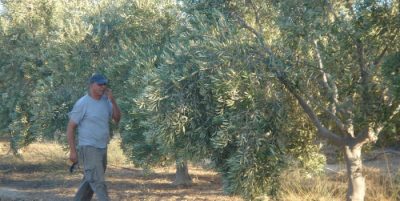 Recovered from an archeological dig, an extinct date variety springs back to green life in the Arava Valley.
Recovered from an archeological dig, an extinct date variety springs back to green life in the Arava Valley.
Dates have always been a staple in the Middle Eastern diet. Mentions of them have come down from ancient times. Now the hope of actually eating the fruit of an extinct variety exists.The story goes back 2000 years.
In the ruins of the Masada fortress, the remains of an entire Jewish community lay for two millenia. Rather than yield to the conquering Romans of the first century, the rebel Jews – men, women, and children, committed collective suicide. Although they set fire to most of the buildings there, they left their food stores intact to show that they had not died of hunger.
Because the site is isolated in the desert and hard to access, it remained undisturbed for 2000 years. Archeological work began there in the 1960s. Inside the ruins were found artifacts, some buried skeletons, and a jar containing fossilized fruit pits, just as they were dumped there two thousand ago by some careful housewife. In the 1970s, the jar was extracted from a collapsed building and the seeds taken out.
“There were wheat grains and pomegranate and lupine seeds, as well as others we couldn’t identify,” says Prof. Elaine Solowey of the Arava Institute for Environmental Studies. “The date pits were initially passed to the botany department at Bar-Ilan University, where they lay there in storage until Dr. Sarah Salon, of the Natural Medicine Research Unit of Hadassah Hospital heard of them in 2005. She transferred them to us.
“I tried all kinds of agricultural tricks, and hoped for the best. Out of three, only one sprouted, in November 2011. We kept the sapling isolated to protect it from pests and agricultural diseases. We also kept its location secret so that no one could steal it. We call it Methuselah.”
It was miraculous enough that the world’s oldest-known viable seed had germinated. But naturally, hopes were high for a fruitful female tree. Prof. Solowey explained that Judean dates were considered the best of all varieties in the ancient world. They were unusually sweet and juicy, exported to Rome and praised by first-century naturalist Pliny the Elder. So closely identified with Israel were they that coins commemorating Rome’s conquest of the land were engraved with the image of a Judean date palm and the words Judea Capta.
When I asked why the variety became extinct, Solowey explained, “This date palm was propagated by offshoots, that is, by hand. When the Jewish farmers were forced out of their lands, there was no one left to do it. Eventually, even its ancient local name was forgotten.”
Can we hope to eat dates from this ancient palm someday?
“Methusaleh is now over 2.5 meters feet tall and has flowered – but he’s a male. We’re considering breeding him to the closest modern relative, the Hiyani date from Eqypt, which was brought in via Sinai. We hope to have fruit within 10 years.”
Judean dates as medicine
According to writings from ancient masters of healing such as Pliny the Elder and Maimonides, Judean dates had medicinal qualities. I asked Prof. Sarah Salon about this.
“As highly nutritious food, dates were considered a tonic, ” she said. “Ancients claimed that they relieved depression and tuberculosis, and made an effective poultice for infected wounds. Dates were also used as part of treatment for infertility and as aphrodisiacs.”
While reserving judgement about depression, tuberculosis, and reproductive remedies, it makes sense that a fruit as high in sugar as dates could draw out infected matter and thus accelerate wound healing. The same can be done with white sugar or honey, in a pinch.
Recently, Methuselah’s age was tested by radioactive isotope Carbon-14, confirming that the tree grew from a seed alive in 35-65 a.d. Imagine tasting dates germinated from Methuselah. Sort of like eating in a time warp! Or for the carnivores among us, tasting an ancient elephant steak.
More on archeological findings in Israel:
Roman-Era Paw Print Found in Jerusalem
The Tooth That Changes Everything
Photo of ancient date pits and Methuselah sprout via nationalgeographic.com.




Yes, there was a jar of seeds of which ONLY THREE SEEDS were for the Judean date palm. The other seeds were different plants like pomegranate, etc.
There is no evidence that there is an entire jar of these seeds, Zach. Prof. Solowey spoke of three date seeds and that out of her attempts to sprout them, only one responded.
Archaeologists found an entire jar of these seeds. If Methuselah is male, why can’t researchers just keep germinating the seeds until one is found to be female? Granted some of them might not work, but Methuselah did, so why can’t more?
thank you for writing this article – have been wondering how the date seed was doing.